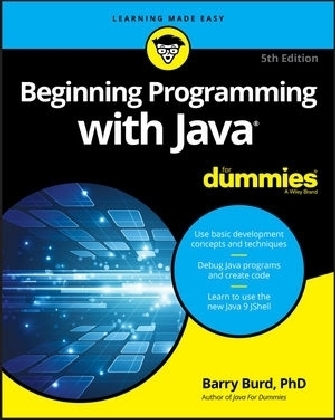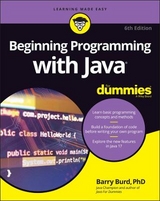
Beginning Programming with Java For Dummies
John Wiley & Sons Inc (Verlag)
978-1-119-23553-8 (ISBN)
- Titel erscheint in neuer Auflage
- Artikel merken
* Updated for Java 9, learn the language with samples and the Java toolkit * Familiarize yourself with decisions, conditions, statements, and information overload * Differentiate between loops and arrays, objects and classes, methods, and variables * Find links to additional resources Once you discover the joys of Java programming, you might just find you're hooked. Sound like fun? Here's the place to start.
Barry Burd, PhD, has been a professor in the Department of Mathematics and Computer Science at Drew University since 1980. He has lectured at conferences in the United States, Europe, Australia, and Asia, and hosts podcasts on various software and technology topics. Dr. Burd also authored Java Programming for Android Developers For Dummies.
Introduction 1
About This Book 1
How to Use This Book 2
Conventions Used in This Book 2
What You Don’t Have to Read 3
Foolish Assumptions 4
How This Book Is Organized 4
Part 1: Getting Started with Java Programming 5
Part 2: Writing Your Own Java Programs 5
Part 3: Controlling the Flow 5
Part 4: Using Program Units 5
Part 5: The Part of Tens 6
Icons Used in This Book 6
Beyond the Book 7
Where to Go from Here 7
Part 1: Getting Started with Java Programming 9
Chapter 1: Getting Started 11
What’s It All About? 11
Telling a computer what to do 12
Pick your poison 13
From Your Mind to the Computer’s Processor 14
Translating your code 14
Running code 15
Code you can use 20
Your Java Programming Toolset 21
A tool for creating code 22
What’s already on your hard drive? 22
Chapter 2: Setting Up Your Computer 23
If You Don’t Like Reading Instructions 24
Getting This Book’s Sample Programs 26
Setting Up Java 27
Downloading and installing Java 29
If you want to find Java on your computer 34
Setting Up the Eclipse Integrated Development Environment 40
Downloading Eclipse 41
Installing Eclipse 43
Running Eclipse for the first time 44
Importing This Book’s Sample Programs 50
What’s Next? 53
Chapter 3: Running Programs 55
Running a Canned Java Program 55
Typing and Running Your Own Code 60
Separating your programs from mine 61
Writing and running your program 62
What’s All That Stuff in Eclipse’s Window? 71
Understanding the big picture 71
Views, editors, and other stuff 72
What’s inside a view or an editor? 74
Returning to the big picture 76
Part 2: Writing Your Own Java Programs 79
Chapter 4: Exploring the Parts of a Program 81
Checking Out Java Code for the First Time 81
Behold! A program! 82
What the program’s lines say 83
The Elements in a Java Program 84
Keywords 85
Identifiers that you or I can define 87
Identifiers with agreed-upon meanings 88
Literals 89
Punctuation 90
Comments 91
Understanding a Simple Java Program 93
What is a method? 93
The main method in a program 96
How you finally tell the computer to do something 97
The Java class 99
Chapter 5: Composing a Program 103
Computers Are Stupid 104
A Program to Echo Keyboard Input 105
Typing and running a program 106
How the EchoLine program works 109
Getting numbers, words, and other things 110
Type three lines of code and don’t look back 112
Expecting the Unexpected 114
Diagnosing a problem 115
What problem? I don’t see a problem 125
Chapter 6: Using the Building Blocks: Variables, Values, and Types 129
Using Variables 130
Using a variable 131
Understanding assignment statements 132
To wrap or not to wrap? 132
What Do All Those Zeros and Ones Mean? 134
Types and declarations 135
What’s the point? 136
Reading Decimal Numbers from the Keyboard 137
Though these be methods, yet there is madness in ’t 138
Methods and assignments 138
Variations on a Theme 140
Moving variables from place to place 140
Combining variable declarations 142
Experimenting with JShell 143
Launching the JShell program 144
Using JShell 145
Chapter 7: Numbers and Types 151
Using Whole Numbers 151
Reading whole numbers from the keyboard 153
What you read is what you get 154
Creating New Values by Applying Operators 156
Finding a remainder 156
The increment and decrement operators 163
Assignment operators 169
Size Matters 171
Chapter 8: Numbers? Who Needs Numbers? 175
Characters 176
I digress 177
One character only, please 179
Variables and recycling 179
When not to reuse a variable 181
Reading characters 183
The boolean Type 187
Expressions and conditions 188
Comparing numbers; comparing characters 189
The Remaining Primitive Types 196
Part 3: Controlling the Flow 199
Chapter 9: Forks in the Road 201
Decisions, Decisions! 202
Making Decisions (Java if Statements) 203
Looking carefully at if statements 204
A complete program 207
Indenting if statements in your code 211
Variations on the Theme 212
Or else what? 212
Packing more stuff into an if statement 214
Some handy import declarations 216
Chapter 10: Which Way Did He Go? 221
Forming Bigger and Better Conditions 221
Combining conditions: An example 224
When to initialize? 226
More and more conditions 227
Using boolean variables 229
Mixing different logical operators together 231
Using parentheses 233
Building a Nest 234
Nested if statements 236
Cascading if statements 237
Enumerating the Possibilities 240
Creating an enum type 241
Using an enum type 241
Chapter 11: How to Flick a Virtual Switch 247
Meet the switch Statement 247
The cases in a switch statement 250
The default in a switch statement 251
Picky details about the switch statement 252
To break or not to break 255
Using Fall-Through to Your Advantage 257
Using a Conditional Operator 262
Chapter 12: Around and Around It Goes 265
Repeating Instructions over and over Again
(Java while Statements) 266
Following the action in a loop 268
No early bailout 270
Thinking about Loops (What Statements Go Where) 271
Finding some pieces 272
Assembling the pieces 274
Getting values for variables 275
From infinity to affinity 276
Thinking about Loops (Priming) 278
Working on the problem 281
Fixing the problem 284
Chapter 13: Piles of Files: Dealing with Information Overload 287
Running a Disk-Oriented Program 288
A sample program 290
Creating code that messes with your hard drive 292
Running the sample program 296
Troubleshooting problems with disk files 298
Writing a Disk-Oriented Program 301
Reading from a file 302
Writing to a file 303
Writing, Rewriting, and Rerewriting 306
Chapter 14: Creating Loops within Loops 309
Paying Your Old Code a Little Visit 310
Reworking some existing code 311
Running your code 312
Creating Useful Code 312
Checking for the end of a file 313
How it feels to be a computer 315
Why the computer accidentally pushes past the end of the file 317
Solving the problem 318
Chapter 15: The Old Runaround 325
Repeating Statements a Certain Number of Times (Java for Statements) 326
The anatomy of a for statement 328
Initializing a for loop 329
Using Nested for Loops 332
Repeating Until You Get What You Need (Java do Statements) 338
Getting a trustworthy response 339
Deleting a file 340
Using Java’s do statement 342
A closer look at the do statement 343
Repeating with Predetermined Values (Java’s Enhanced for Statement) 345
Creating an enhanced for loop 345
Nesting the enhanced for loops 347
Chapter 16: Using Loops and Arrays 353
Some Loops in Action 353
Deciding on a loop’s limit at runtime 355
Using all kinds of conditions in a for loop 358
Reader, Meet Arrays; Arrays, Meet the Reader 360
Storing values in an array 364
Creating a report 365
Initializing an array 367
Working with Arrays 368
Looping in Style 372
Deleting Several Files 373
Part 4: Using Program Units 381
Chapter 17: Programming with Objects and Classes 383
Creating a Class 384
Reference types and Java classes 385
Using a newly defined class 386
Running code that straddles two separate files 387
Why bother? 389
From Classes Come Objects 389
Understanding (or ignoring) the subtleties 392
Making reference to an object’s parts 392
Creating several objects 393
Another Way to Think about Classes 396
Classes, objects, and tables 396
Some questions and answers 397
What’s Next? 398
Chapter 18: Using Methods and Fields from a Java Class 401
The String Class 402
A simple example 402
Putting String variables to good use 403
Reading and writing strings 405
Using an Object’s Methods 406
Comparing strings 409
The truth about classes and methods 410
Calling an object’s methods 412
Combining and using data 412
Static Methods 413
Calling static and non-static methods 415
Turning strings into numbers 415
Turning numbers into strings 417
How the NumberFormat works 419
Your country; your currency 419
Understanding the Big Picture 421
Packages and import declarations 421
Shedding light on the static darkness 423
Barry makes good on an age-old promise 424
Chapter 19: Creating New Java Methods 431
Defining a Method within a Class 431
Making a method 432
Examining the method’s header 433
Examining the method’s body 434
Calling the method 435
The flow of control 436
Using punctuation 437
The versatile plus sign 438
Let the Objects Do the Work 441
Passing Values to Methods 442
Handing off a value 445
Working with a method header 446
How the method uses the object’s values 447
Passing more than one parameter 448
Getting a Value from a Method 450
An example 450
How return types and return values work 452
Working with the method header (again) 454
Chapter 20: Oooey GUI Was a Worm 457
The Java Swing Classes 458
Showing an image on the screen 459
Just another class 462
The Swing Classes: Round 2 467
Extending a class 468
Code Soup: Mixing XML with Java 470
Using JavaFX and Scene Builder 473
Installing Scene Builder 473
Installing e(fx)clipse 474
Creating a bare-bones JavaFX project 475
Running your bare-bones JavaFX project 476
Adding Stuff to Your JavaFX Project 477
Taking Action 482
Part 5: The Part of Tens 489
Chapter 21: Ten Websites for Java 491
This Book’s Website 491
The Horse’s Mouth 491
Finding News, Reviews, and Sample Code 492
Looking for Java Jobs 492
Got a Question? 492
Chapter 22: Ten Useful Classes in the Java API 493
ArrayList 493
File 494
Integer 494
JFrame 494
JOptionPane 495
Math 496
NumberFormat 496
Scanner 497
String 497
System 497
Index 499
| Erscheinungsdatum | 19.08.2017 |
|---|---|
| Verlagsort | New York |
| Sprache | englisch |
| Maße | 191 x 232 mm |
| Gewicht | 738 g |
| Themenwelt | Informatik ► Programmiersprachen / -werkzeuge ► Java |
| Informatik ► Software Entwicklung ► Objektorientierung | |
| Mathematik / Informatik ► Informatik ► Web / Internet | |
| ISBN-10 | 1-119-23553-7 / 1119235537 |
| ISBN-13 | 978-1-119-23553-8 / 9781119235538 |
| Zustand | Neuware |
| Haben Sie eine Frage zum Produkt? |
aus dem Bereich



